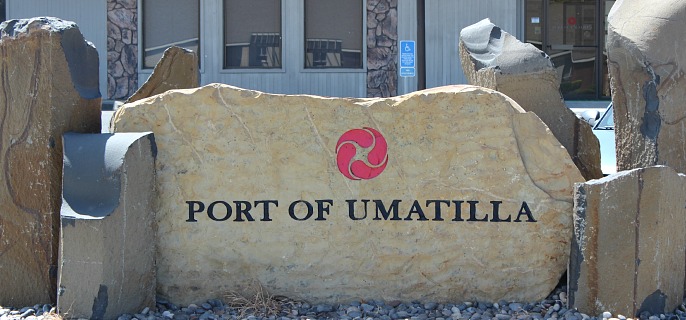
PHOTOS BY JENNIFER COLTON
Tonight, the Umatilla City Council will hear an appeal of a zoning issue. What sounds mundane could cause high-stakes ripples to major players in the city.
The piece of land on Port of Umatilla property is at the heart of the appeal. It is nondescript, empty and worth a just $10,000. Grass and sagebrush occupy the property between Bud Draper Road and Big River Golf Course. On one side, loaded semis pass by from industrial sites; on the other, golfers tee off in the relative quiet of the golf course.
In the middle is the Schrodinger’s properties, which are zoned both industrial and residential.
The Port of Umatilla claims the site is zoned industrial and open for planned development. The city of Umatilla and the owners of Big River Golf Course, however, argue the property is residential.
Last month, the Umatilla Planning Commission denied a plan to build a $1.5 million freight warehouse on the property on the recommendation of Umatilla City Planner Bill Searles and a land use attorney the city hired who determined the property is residential, despite city maps showing an industrial designation.
The Port of Umatilla, Port General Manager Kim Puzey, and property owner Hammer Industries have each appealed the decision.
“The issue is small, but very important,” Puzey said. “If, in fact, the city were to prevail in this, the port will be sued. We relied upon the official maps of the city of Umatilla and others to make these decisions.”

Puzey also brings out two pieces of correspondence the port received from the city on April 1. In one, an e-mail, the land use attorney hired by the city announced she has determined the property is residential. In the other, an annual review of another port property, the map attached shows the property as industrial.
“On the very same day, I get that the property is industrial and residential,” Puzey says.
Like the port, Searles considered the property industrial until the owner of Big River Golf Course approached him last summer and asked for a copy of the ordinance that made in industrial.
“I wasn’t ever in a position to research that before,” Searles said. “When I started researching, I expected to find an ordinance that said, ‘on this day, the council adopted a comprehensive plan for that property,’ but there isn’t one.”
According to Searles, the property was zoned single-family residential as of 1977. At that time, the golf course had been established, no industrial properties existed in the immediate area, and the port had sold the strip of property to a developer who planned to put in a housing subdivision. That developer went bankrupt and the port bought it back in 1987.
In Searles’ research, the last ordinance about the property was a request from the Port of Umatilla in 1989 to re-zone property on both sides of Bud Draper lane. At that time, the city agreed to change the property on the east side – furthest from Big River – but denied the change to the west side. In the city’s records, the property never officially changes to industrial, but it appears so in all maps for the past decade.
When questioned how this happened, Searles brings out Ordinance 689, adopted June 15, 1999. The ordinance approves an official comprehensive plan and zoning map for the city of Umatilla that was designed to clean up and update the city’s map with all zoning changes since the 1970s.
On the map, the Bud Draper subdivision is zoned residential; however, the black-and-white dash pattern used for R-1 residential is very similar to that used for the industrial property adjacent to it. Searles theorizes the consultants hired in 2000 to produce a new full-color map, highlighting the city’s downtown district, lumped the subdivision in with the property around it, not realizing the pattern differed.
Searles stressed the map did not actually change the zoning, but admits the city has believed both the plan and zoning for that area were industrial since 2004, when the consultants’ released the updated map.
“The map didn’t update any properties without other ordinances changing them,” he said. “Regardless of what the map shows, it’s still an error because the ordinance did not purport to change the zoning of any properties. To me, that says the consultants screwed up. This was a map error.”
The port has another card in its arsenal, however: zoning is approved by the county, not the city.
Searles agreed, but said the city of Umatilla had “lead planning” authority for the area, which means city groups would have delineated where they wanted development. Umatilla County was then responsible for adopting zoning and applying it based on the city’s plan.
“Way back to 1972, county maps show the property as industrial, but once the city adopted the plan in 1977, it became incumbent upon the county to update their maps,” Searles said. “In our understanding of case law, comprehensive plan designation basically trumps zoning.”
According to the minutes of the Umatilla County Planning Commission meeting from Jan. 23, 2014, the county considers the property industrial.
“If the city prevails and Bill Searles is correct and this is residential, every previous planner, every previous city manager, every current and previous member of the planning commission, city council, every mayor has been operating in a way they have missed this,” Puzey said.
The decision impacts not only the individual parcel, but the entire strip of land separating the course and Bud Draper Road. Of that land, one parcel has been developed: the Aramark building. The two neighboring parcels have also been sold with the intention of developing as industrial property.
“The reason that we are having to pursue this is the port sold these properties with the intent to develop these,” Puzey said.
The city and port have met to attempt to resolve, the issue but the sides could not agree on a solution. The port wants the property officially zoned industrial to match the maps; the city stands by the 1977 plan that the property is intended to be residential.
“We don’t have the authority to just disregard the opinion of the city council and say, ‘Well, it’s been so long, who will know the difference,’” Searles said. “To allow a map error to change the zoning of a property is just wrong.”
For now, the port is following the civil process for their proposal: planning commission with appeal to city council with appeal to the Land Use Board of Appeals. Puzey, however, points out if the city decides the property is residential, then they have violated a state law requiring accurate zoning maps on file. If the port files a claim that the city has violated state law, the issue could go to circuit court, then appellate courts, all the way up to the Supreme Court.
“Whether the port prevails or not, I think someone will appeal to LUBA. If the port wins, the golf course will go to LUBA. If the city wins, the port will go to LUBA,” Searles said. “We’d be more than happy to sit down with all the property owners to come up with a solution, but that would require the cooperation of everybody and, at this point, I just don’t know if that’s possible.”
In that way, Searles and Puzey agree. Puzey describes the debate in two ways: the issue and the sideshow. To the port manager, the issue is the zoning, how the issue occurred and how the involved parties move on; everything else is the sideshow.
“Whether or not someone wants to play golf, whether the deer come up and graze, whether someone doesn’t like the color of the paint has no bearing whatsoever,” he said. “This is about the law, and we have an obligation to make them follow the law.”
The hearing will take place this evening in the council chambers at Umatilla City Hall, 600 Sixth St. The city council meeting begins at 7 p.m.
More Stories from Northeast Oregon Now:
Umatilla Fine-Tunes Council Leadership
Solar Project Could Cut HAREC Power Costs by Half








